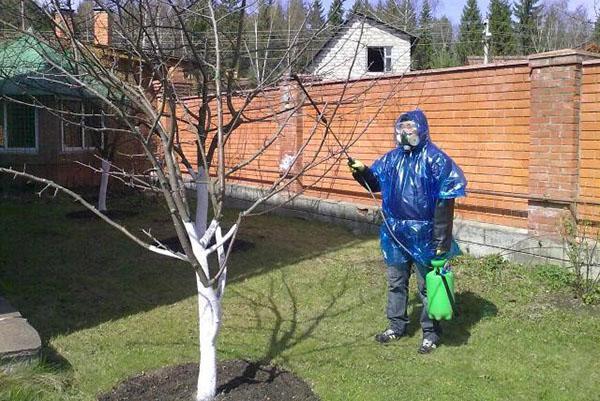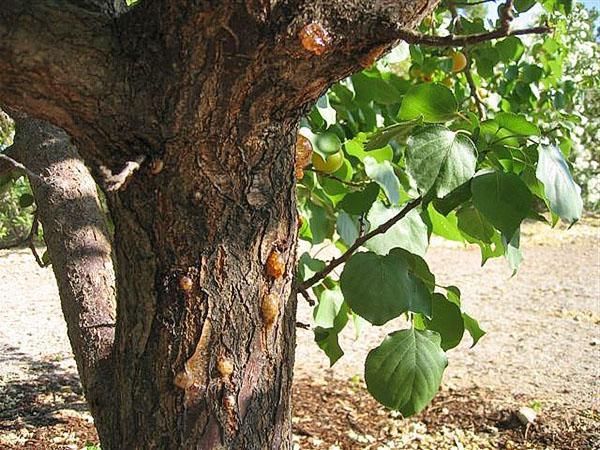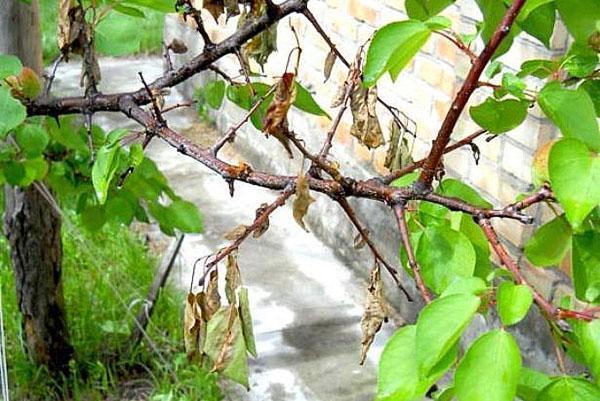Diseases of apricot trees and their treatment - photo and description of signs
 Our beloved apricot comes from the warm regions of Armenia, India, China. Diseases of apricot trees and their treatment - photo on the page, are associated with changing living conditions. In a climate uncharacteristic for a tree, fungal and non-infectious diseases develop, reducing the productivity of the garden. Only prevention and proper care will help prevent the spread of disease.
Our beloved apricot comes from the warm regions of Armenia, India, China. Diseases of apricot trees and their treatment - photo on the page, are associated with changing living conditions. In a climate uncharacteristic for a tree, fungal and non-infectious diseases develop, reducing the productivity of the garden. Only prevention and proper care will help prevent the spread of disease.
Diseases and their treatment

If the garden is affected by apricot diseases, then the fight against them should be systematic. But for this you should know the signs, dangerous periods, and methods of treating each ailment.
Distinguish types of diseases:
- physiological;
- bacterial;
- fungal;
- viral.
To treat a disease, you need to know its signs. There is a guide where there are photos of diseases of apricot trees and their treatment is described. The disease can be prevented by preventive measures - to acquire seedlings that are tolerant to diseases common in the region, to carry out protective measures, and to carry out agrotechnical measures during the period.
Moniliosis is the most common disease in apricot orchards
 Moniliosis is caused by the introduction of the marsupial fungus Monilia. The disease develops in two forms - it affects the foliage and causes gray rot of the fruit.
Moniliosis is caused by the introduction of the marsupial fungus Monilia. The disease develops in two forms - it affects the foliage and causes gray rot of the fruit.
Disease on the leaves should be expected after a warm winter. If the flowering period coincides with humid foggy weather, spores penetrate the wood through the open pistil of the petal. In this case, the flower turns brown, the affected wood does not supply the leaf with food.
Namely, infection moniliosis is the reason why apricot dries after flowering. The leaves do not fall, they mummify, but cracks appear on the branches, which the tree seeks to patch, releasing gum.
A measure of the fight against monial burns is to cut out the damaged branches twice, during the onset of the disease and after 2-3 weeks. Copper treatment will reduce the growth of the Monilia fungus. Prevention - autumn whitewashing of the garden with the addition of cuproxate to lime.
 Apricot moniliosis and the fight against it will be required at the height of summer, in a warm, humid season. When the crop is ready to ripen, the fruits become covered with a white, gray, fluffy bloom, then rot. Such fruits must be collected and destroyed. But already in winter, trees are treated with Bordeaux liquid three times. In the spring, even before flowering, the garden is treated on a green cone, on the buds with fungicides:
Apricot moniliosis and the fight against it will be required at the height of summer, in a warm, humid season. When the crop is ready to ripen, the fruits become covered with a white, gray, fluffy bloom, then rot. Such fruits must be collected and destroyed. But already in winter, trees are treated with Bordeaux liquid three times. In the spring, even before flowering, the garden is treated on a green cone, on the buds with fungicides:
- Horus;
- Nitrafen;
- Insecticides.
Treatment against insects is necessary as they transfer rot to healthy ovaries.
Next year, the weakened plant must be freed from part of the crop by removing branches, thinning the plant. At the same time, this technique is prophylactic against fungal diseases.
Clasterosporia or perforated spot
 You are carefully examining the through holes, looking for a leaf beetle, and before you is a fungal disease - apricot clotterosporia.Initially, small light specks will appear, pressed into the plate. Then necrosis, and a hole appears. If you do not take action, there are more spots, the sheet collapses. The source of the disease can be a fungus, infection or disturbances in agricultural technology. So, the leaves can be burned during preventive treatment, if you exceed the dose of chemicals, the tree can be weakened by the infection. But if there are no other reasons, it is a mushroom, and treatment is needed with fungicides. And the wounds that have appeared, where gum oozes, must be treated and closed with garden pitch.
You are carefully examining the through holes, looking for a leaf beetle, and before you is a fungal disease - apricot clotterosporia.Initially, small light specks will appear, pressed into the plate. Then necrosis, and a hole appears. If you do not take action, there are more spots, the sheet collapses. The source of the disease can be a fungus, infection or disturbances in agricultural technology. So, the leaves can be burned during preventive treatment, if you exceed the dose of chemicals, the tree can be weakened by the infection. But if there are no other reasons, it is a mushroom, and treatment is needed with fungicides. And the wounds that have appeared, where gum oozes, must be treated and closed with garden pitch.
Fruit crumbling
 It seems that for no reason, still green or yellow fruits without taste begin to crumble, freeing the branches from the load. Why is the apricot crumbling? There are many reasons. Perhaps the tree is overloaded with fruit and food is scarce. The owner did not regulate the load, and the exhausted tree gets rid of the harvest.
It seems that for no reason, still green or yellow fruits without taste begin to crumble, freeing the branches from the load. Why is the apricot crumbling? There are many reasons. Perhaps the tree is overloaded with fruit and food is scarce. The owner did not regulate the load, and the exhausted tree gets rid of the harvest.
Perhaps a hurricane wind passed through the site and threw off the fruit. But temperature drops, barrel damage give the same result. The tree is waiting for apoplexy if the temperature dropped to 0 degrees. The cell sap froze, the cells were suffocated, the leaves drooped and wilted. After that, the affected tree begins to dry out and it is no longer up to the harvest. Bacteria and fungi are then introduced into the affected tissues. Treatment of apoplexy consists in the treatment of copper-containing preparations, cutting the affected branches.
How to prevent gum flow
 Gum is a protective sticky secretion of a tree - glue, resin, diluted with sap. What to do if apricot gum flow takes away its vitality? The disease is called gommosis, typical for stone fruit crops.
Gum is a protective sticky secretion of a tree - glue, resin, diluted with sap. What to do if apricot gum flow takes away its vitality? The disease is called gommosis, typical for stone fruit crops.
The secreted gum is a sticky, thick substance designed to close wounds, like an adhesive plaster. A medicinal substance used in traditional medicine. An open wound, the crack must heal. But the penetrated fungi and bacteria prevent, the wood is destroyed, the outflow continues, weakening the wood.
Proper care can prevent the appearance of growths:
- do not injure the bark of the tree;
- avoid frostbites and sunburn;
- do not do traumatic pruning during sap flow;
- use zoned varieties in breeding.
Apricot whitewash 3 times a year - in summer, in winter and in autumn. Wrapping the trunk in burlap in winter will help. A balanced soil calcium composition is important to stop gum excretion. Excess calcium can be removed if watered with a weak solution of potassium permanganate during the season.
 There are many methods of dealing with gum flow, as well as the reasons for the ailment. The main thing is to find the cause and, after its elimination, carry out agrotechnical measures. The diseases of apricot trees shown in the photo and their treatment most often form a complex, the signs are intertwined. A specialist agronomist will be able to clarify.
There are many methods of dealing with gum flow, as well as the reasons for the ailment. The main thing is to find the cause and, after its elimination, carry out agrotechnical measures. The diseases of apricot trees shown in the photo and their treatment most often form a complex, the signs are intertwined. A specialist agronomist will be able to clarify.
Hello! Tell me, the bark of a 2-year-old apricot is covered with cracks, what should I do? To clean or transfer a tree to a bowl and if translated, when is it better to do it? Thank you in advance!
Such cracks appear as a result of an incorrectly chosen landing site, severe frosts and a sharp change in temperature. Young seedlings suffer. Cover all cracks with garden varnish or clay mash. Now, transferring the tree to the bowl is not worth it. Check the trunk in the spring and make a decision based on the results of the check.
Thank!
I planted an apricot tree from a box. The leaves are curling inward! What is it and what to do?
There can be many reasons. Most often, the leaves curl as a result of the disease. So, a similar phenomenon happens with a defeat of moniliosis (then the leaves seem to be burned, and the twigs become brown). Treatment with Topaz or Topsin will help - M.If, at the beginning, yellow blisters appeared on the leaves, and then the foliage turned red and twisted, this is curliness. We need treatment with copper-containing preparations. Leaves are spinning, first from the bottom of the tree, and with verticillosis. Here you need Previkur or Vitaros
Hello, apricot leaves turn yellow, what could be the reason ?!
Sincerely, Vitaly
There can be many reasons, ranging from a banal lack of nutrition (then you need to feed with complex fertilizer). Also look for pests such as aphids. If there are insects, you need to treat with an insecticide. If the leaves turn yellow and start spinning, this is a fungal disease called verticilliosis. Spraying with a fungicide (Fundazol) is needed.